It seems we can’t find what you’re looking for. Perhaps searching can help.
Sign Up for newsletter!
Subscribe to get the latest eBook!
Hotline






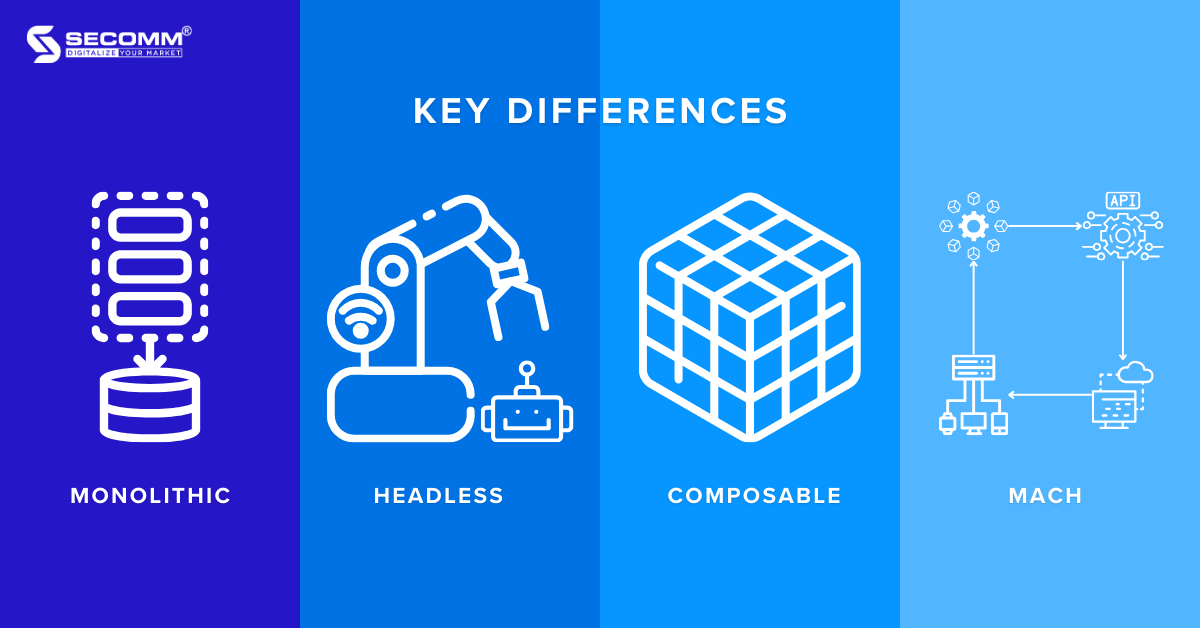
The eCommerce sector is experiencing rapid growth, with global retail sales reaching 5.7 trillion USD in 2022 and projected to hit 6.3 trillion USD in 2023, as reported by Insider Intelligence. This requires businesses to adopt more efficient and flexible eCommerce architectural solutions to meet customer demands for online shopping experiences.
However, there is no one-size-fits-all eCommerce architectural solution. Each architecture comes with its own set of advantages and disadvantages, catering to different goals and requirements. Hence, businesses must discern between eCommerce architectures to choose the most fitting one for their business model.
This article will introduce the four most common eCommerce architectures: Monolithic, Headless, Composable, and MACH. Also, it’ll compare and evaluate these architectures based on criteria such as cost, scalability, customization, security, and performance.
Monolithic architecture is a traditional and long-standing model in eCommerce development. In this approach, the entire eCommerce website is built as a unified application on a single source codebase.
This means that both the user interface (frontend) and business logic (backend) are combined and implemented within a comprehensive “all-in-one” system. So, modifications to specific eCommerce components may have repercussions on the overall functionality of the system.
Pros:
Cons:
The Monolithic architecture can be used in case your business is implementing a small-scale, straightforward eCommerce system, seeking a rapid market launch without immediate plans for significant future development. However, architectures like Headless or Composable would be more appropriate as the system grows and expands, requiring increased customization and scalability
The Headless architecture is a popular architectural solution in eCommerce, where the user interface (frontend) of the eCommerce website is decoupled from the operational system (backend). The Headless architecture is often called “API-first” because the frontend and backend communicate with each other through an API layer.
Many businesses opt for the Headless Commerce model to create and customize user interfaces (frontends) to provide customers with a rich and seamless shopping experience across various channels such as websites, mobile apps, IoT, and POS. These user interfaces can connect to a single backend system through an API layer, enabling businesses to engage in multi-channel commerce and rapidly expand internationally.
Pros:
Cons:
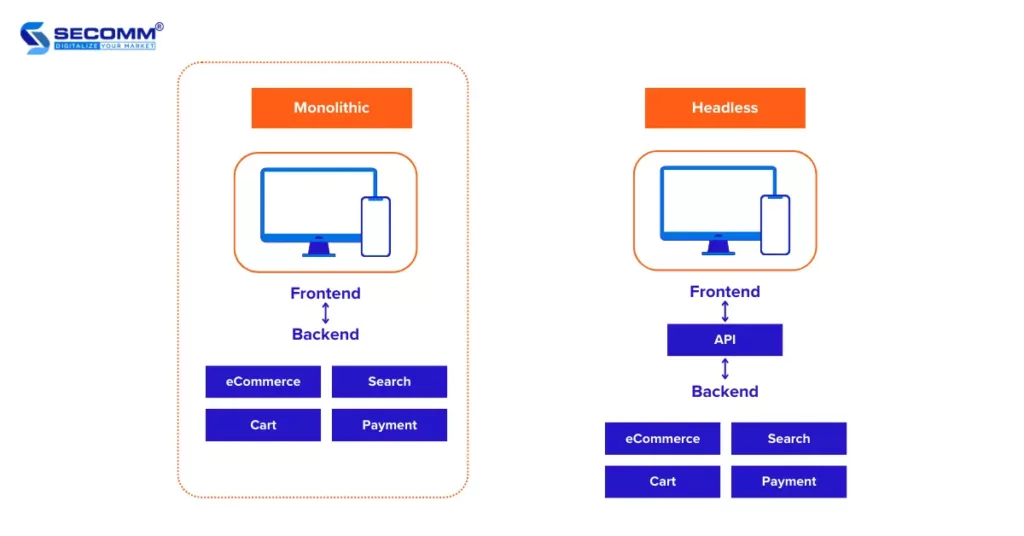
Deploying Headless Commerce may be suitable for businesses that require flexibility to create and customize multiple user interfaces for multi-channel sales purposes and expand their business globally. In particular, businesses that demand independent development of both frontend and backend, as well as the need for integration with various third-party systems, should prioritize the Headless architecture.
If the standout feature of the Headless architecture is the separation of frontend and backend, providing scalability and flexible customization, then the Composable architecture, also known as Module-driven architecture, takes it a step further by decoupling all eCommerce components such as Search, Payment, Cart, etc.
This allows businesses to select components and package them into Packaged Business Capabilities (PBC) to create a specialized and comprehensive eCommerce website solution.
Pros:
Cons:
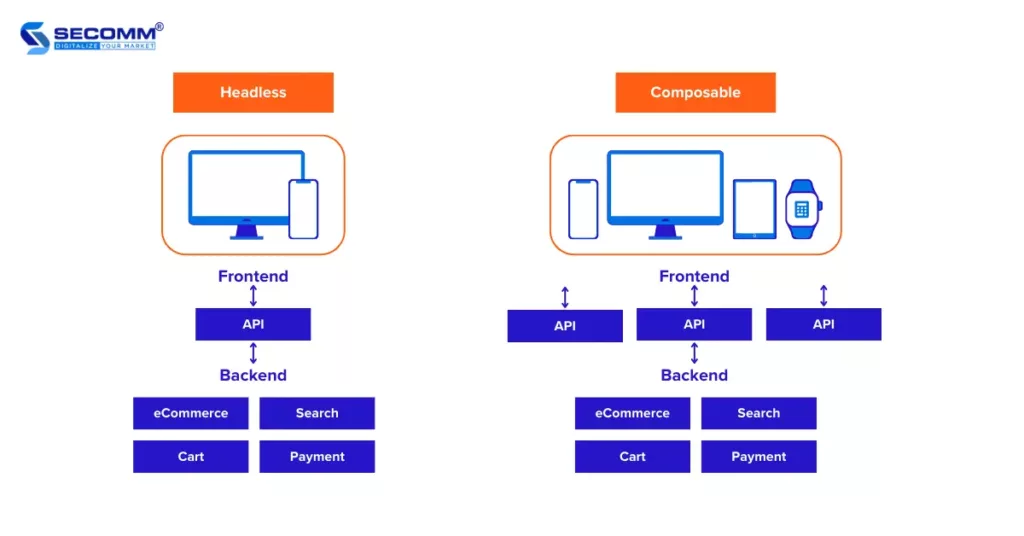
Composable architecture is suitable for cases where businesses undertake large projects, have high demands for flexibility and customization, need to integrate multiple services and third-party systems, as well as require complete independence between the components of the eCommerce system.
The MACH architecture is the most modern approach for building and developing highly flexible eCommerce websites. This architecture allows businesses to integrate leading technologies into a single system, incorporating Microservices-based, API-first, Cloud-native, and Headless components.
Pros:
Cons:
MACH architecture is suitable for businesses with ample budgets aiming to implement large projects based on the four MACH technologies and with high requirements for customization and scalability. It is also beneficial if they have in-house expertise or collaborate with highly specialized development teams.
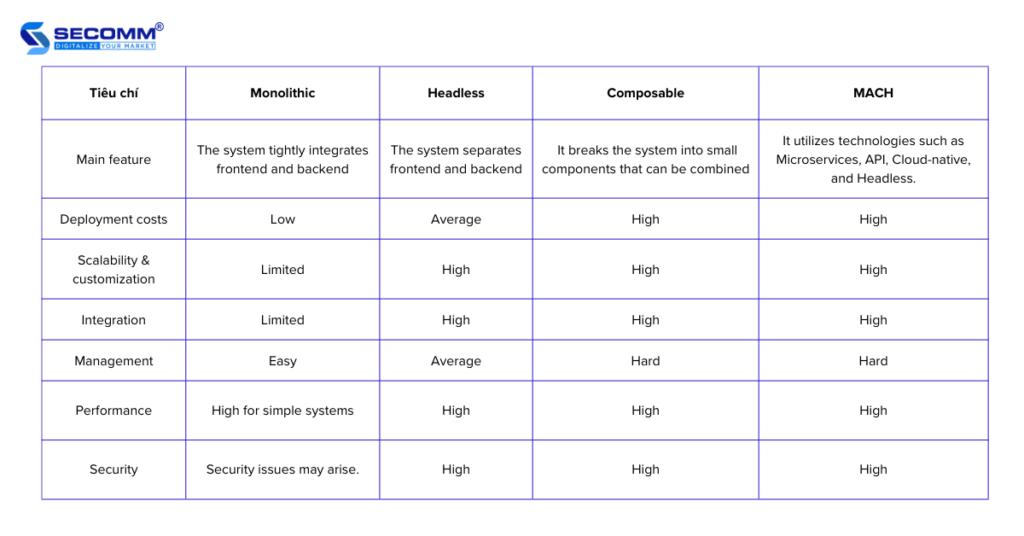
Above is a summary of the essence of the four eCommerce website deployment architectures: Monolithic, Headless, Composable, and MACH. While Monolithic may seem outdated and has many limitations, the Composable and MACH architectures are innovative, providing more optimal and flexible development solutions, but their deployment and operation processes are complex, requiring a highly skilled development team. Therefore, Headless becomes a valuable architectural solution compared to the other three choices for implementing eCommerce websites at the current time.
Headless Commerce is the most popular solution today, with a 25% increase in demand for Headless Commerce deployment in the past two years. Implementing Headless allows businesses to create a customized and multi-channel user experience by integrating with leading tools and technologies. To effectively develop Headless Commerce, businesses need to collaborate with a development team with high skills and expertise, as well as a well-thought-out strategy.
With extensive technical experience and high expertise in the e-commerce field, SECOMM has successfully consulted and implemented Headless Commerce for leading businesses such as Vinamilk, and Suzuverse, based on one of Shopify’s three solutions:
Contact SECOMM or call directly on the hotline (02871089908) to explore how we can support businesses in maximizing the potential of Headless Commerce and enhancing competitiveness in the eCommerce market.
 2
2
 6,436
6,436
 0
0
 1
1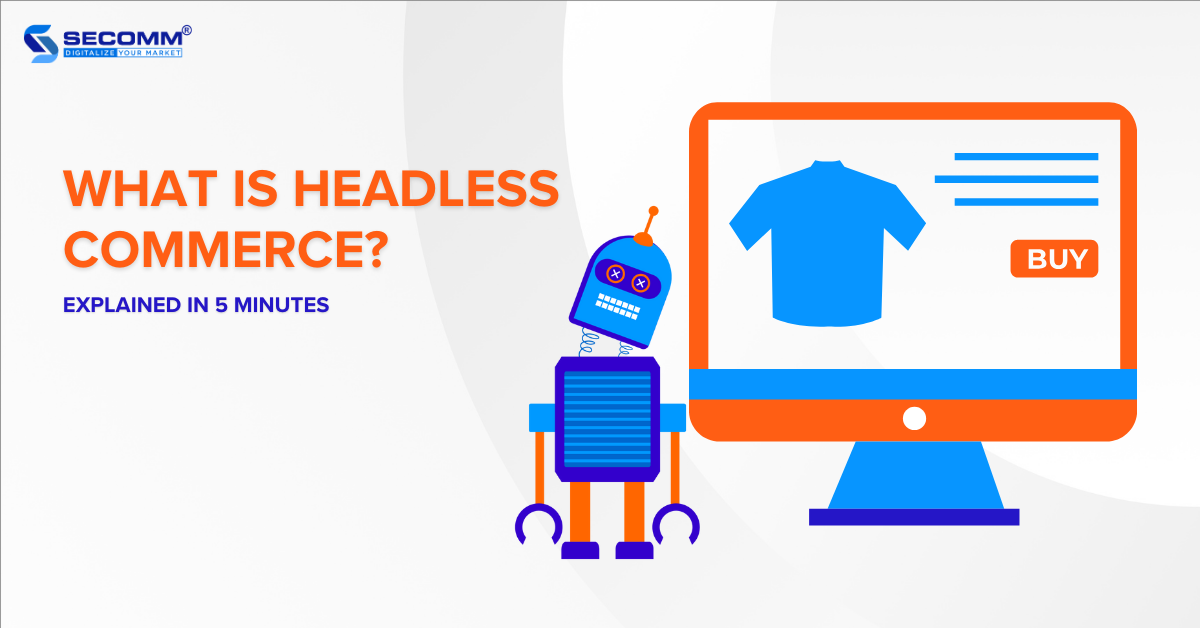
When learning the significant changes in eCommerce over the past decade, one concept that cannot be ignored is Headless Commerce. It isn’t a mere trend; rather, it presents a revolutionary solution for how businesses implement eCommerce, aiming to provide flexibility and enhanced efficiency in delivering a seamless shopping experience for customers.
The following statistics contribute to proving that Headless Commerce is one of the fastest-growing trends in eCommerce:
So, what is Headless Commerce, and why is it considered a modern and flexible approach to eCommerce deployment? Let’s explore this in the following article.
Headless Commerce is an eCommerce architecture that separates the user interface (Frontend) from the data management and functionality (Backend) of an eCommerce website. This separation allows the frontend and backend to be built entirely independently and connected through eCommerce Application Programming Interfaces (APIs).
Going Headless allows you to use any technology or tool you prefer to design and customize the user interface without being dependent on the existing eCommerce platform. You can also update and modify the backend without affecting the frontend.
Learn more: Everything to know about eCommerce APIs
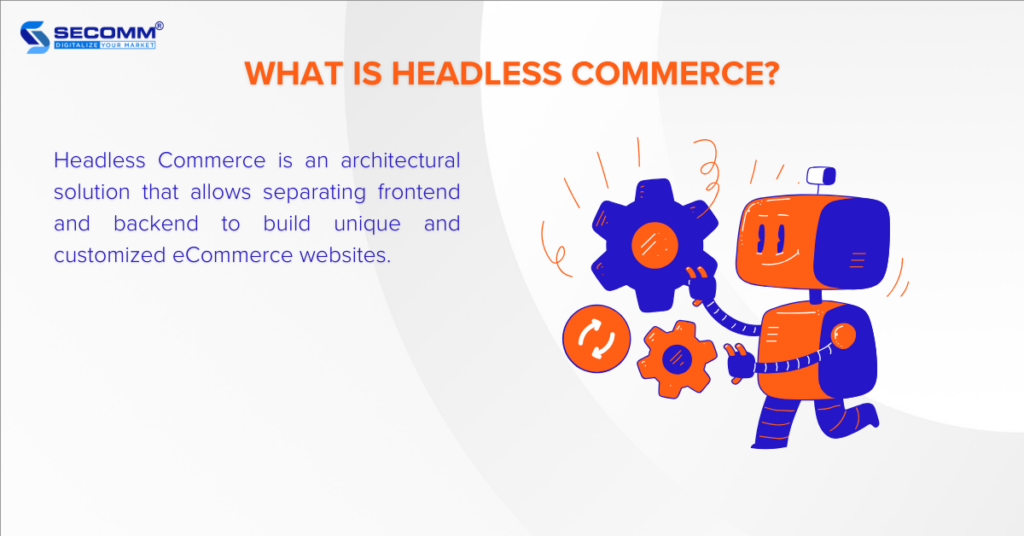
Trước khi giải pháp Headless Commerce, hầu hết các website thương mại điện tử đều được xây dựng với kiến trúc Monolithic – tức là phần frontend và backend được liên kết chặt chẽ với nhau trong một hệ thống duy nhất. Đây là cách tiếp cận truyền thống và đơn giản, giúp doanh nghiệp dễ dàng xây dựng và quản lý website thương mại điện tử của mình.
However, Monolithic Commerce comes with several limitations, especially when you aim to develop and scale your eCommerce systems. Some common issues encountered when implementing Monolithic Commerce include:
In contrast to Monolithic Commerce, Headless architecture brings several benefits when developing eCommerce. Some of these include:
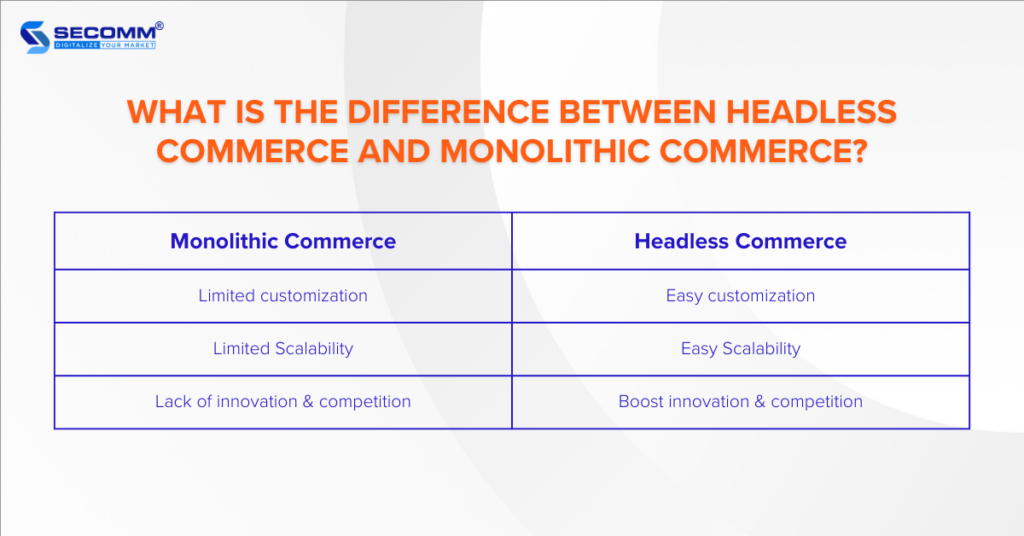
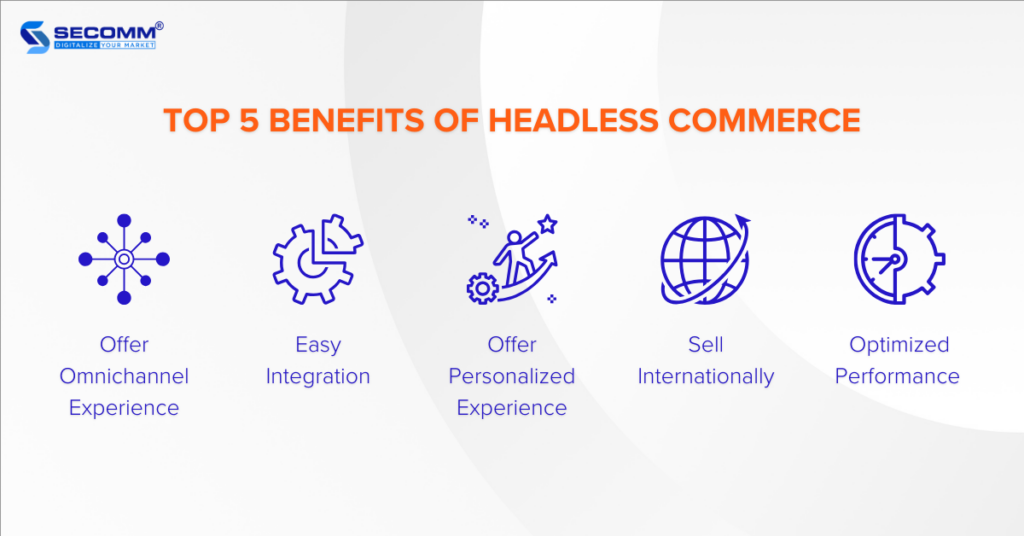
The Headless Commerce model allows you to customize and create a unique user experience across various channels (website, mobile app, IoT). This not only avoids impacting the backend system but also helps you reach more potential customers and boost conversion capabilities.
You can effortlessly integrate and merge various third-party systems (CRM, CMS, ERP, DXP) into the backend using APIs. This integration enhances the efficiency of managing and executing eCommerce activities, enabling you to leverage the superior capabilities of multiple services without concerns about website compatibility or performance issues.
Through seamless integration with various systems, you can collect and consolidate customer data from various sources such as CRM, advertising campaigns, or data from previous shopping experiences.
Going Headless, you can create a customized interface based on customer data and personal information, displaying unique content, products, and messages for each customer based on their preferences, shopping behavior, and transaction history.
Deploying Headless Commerce enables you to expand your operations into international markets by adapting their activities to effectively cater to diverse markets. Specifically, you can customize the user interface, manage content, and offer distinct views for each customer segment in various markets.
Moreover, you can seamlessly integrate local options for payment, delivery, language, and currency to enhance the local customer experience.
In the Headless architecture, the frontend and backend operate independently through APIs, allowing businesses to optimize the performance of both parts. For example, you can enhance the navigation and page loading speed of frontends (website, mobile app, IoT) without heavily relying on the backend’s performance.
Similarly, you can optimize the backend to efficiently handle product requests, transactions, or inventory without impacting the page loading speed of the frontends
Headless Commerce is a highly innovative eCommerce solution. However, that doesn’t mean this solution is suitable for every business. Therefore, before deciding to implement Headless for an eCommerce website, you need to consider the following factors:
Ready to go Headless?
Over time, Headless Commerce has played a crucial role in reshaping how businesses implement eCommerce. This model provides you with many benefits in terms of customization, scalability, and delivering a multi-channel experience for customers. However, before deciding to deploy Headless, you’ll need to consider issues related to business goals, budget and resources, development needs, and the go-live timeline.
When ready to implement Headless, you’ll choose top platforms supporting Headless Commerce. One of these platforms is Shopify, a renowned SaaS platform that has introduced several solutions for businesses to deploy Headless.
With extensive technical expertise and high specialization in the eCommerce domain, SECOMM has successfully consulted and implemented Headless Commerce using one of Shopify’s three solutions for leading enterprises such as Vinamilk, Suzuverse, and more.
Contact SECOMM or call directly at the hotline (02871089908) to explore how we can support businesses in maximizing the potential of Headless Commerce and enhancing competitiveness in the eCommerce market.
 2
2
 6,966
6,966
 0
0
 1
1Subscribe to get the latest eBook!
Hotline